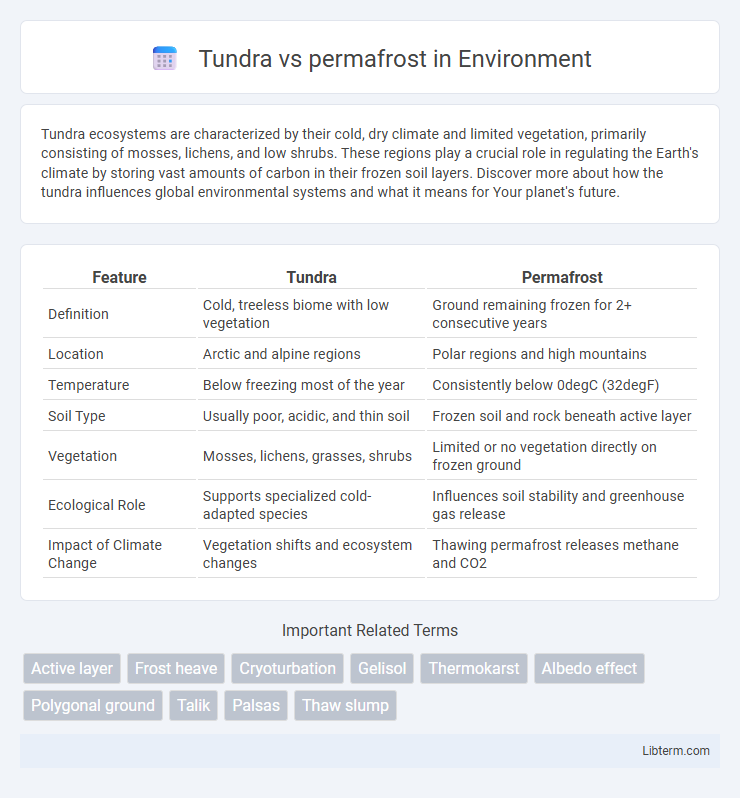Tundra ecosystems are characterized by their cold, dry climate and limited vegetation, primarily consisting of mosses, lichens, and low shrubs. These regions play a crucial role in regulating the Earth's climate by storing vast amounts of carbon in their frozen soil layers. Discover more about how the tundra influences global environmental systems and what it means for Your planet's future.
Table of Comparison
| Feature | Tundra | Permafrost |
|---|---|---|
| Definition | Cold, treeless biome with low vegetation | Ground remaining frozen for 2+ consecutive years |
| Location | Arctic and alpine regions | Polar regions and high mountains |
| Temperature | Below freezing most of the year | Consistently below 0degC (32degF) |
| Soil Type | Usually poor, acidic, and thin soil | Frozen soil and rock beneath active layer |
| Vegetation | Mosses, lichens, grasses, shrubs | Limited or no vegetation directly on frozen ground |
| Ecological Role | Supports specialized cold-adapted species | Influences soil stability and greenhouse gas release |
| Impact of Climate Change | Vegetation shifts and ecosystem changes | Thawing permafrost releases methane and CO2 |
Understanding Tundra: A Brief Overview
Tundra is a cold, treeless biome characterized by low temperatures and short growing seasons, primarily found in Arctic regions. It features a layer of permanently frozen subsoil known as permafrost, which significantly affects soil drainage and vegetation growth. Understanding tundra ecosystems involves recognizing the interplay between active surface layers and underlying permafrost that shapes habitat conditions.
What is Permafrost? Definition & Key Features
Permafrost is a layer of soil or rock that remains frozen for at least two consecutive years, commonly found in polar regions and high mountain environments. It acts as a critical component in the Earth's cryosphere, influencing soil stability, hydrology, and carbon storage. The active layer above the permafrost thaws seasonally, impacting vegetation growth in tundra ecosystems and contributing to greenhouse gas emissions when it decomposes.
Geographic Distribution: Where Are Tundra and Permafrost Found?
Tundra primarily exists in the high-latitude regions of the Arctic and Antarctic, spanning parts of North America, Europe, and Asia, characterized by low temperatures and limited vegetation. Permafrost underlies much of the Arctic tundra and subarctic regions, extending across Siberia, Alaska, northern Canada, and Greenland, where soil remains frozen for at least two consecutive years. These geographic distributions influence ecosystem dynamics, carbon storage, and climate interactions unique to polar and subpolar environments.
Climate Conditions: Tundra vs Permafrost
Tundra climate features long, cold winters and short, cool summers with low precipitation, primarily as snow. Permafrost refers to ground that remains continuously frozen for at least two years, often underlying tundra regions. The presence of permafrost significantly influences soil temperature and moisture, affecting vegetation and ecosystem stability in tundra environments.
Soil Composition and Structure
Tundra soils are characterized by a shallow active layer rich in organic material and limited nutrient content, underlying which lies permafrost--a permanently frozen soil layer that restricts water drainage and root penetration. Permafrost maintains a complex ice-rich structure, causing soil expansion and contraction that influences tundra vegetation patterns and carbon storage. Differences in soil composition and structure between tundra active layers and underlying permafrost critically affect ecosystem dynamics and climate feedback mechanisms.
Flora and Fauna Adaptations
Tundra ecosystems host specialized flora such as low-growing shrubs, mosses, and lichens adapted to short growing seasons and nutrient-poor soils. Permafrost regions limit plant root depth, leading to shallow-rooted vegetation and creating unique habitats for fauna like arctic foxes, caribou, and migratory birds that have developed physiological and behavioral adaptations to extreme cold. Both environments drive evolutionary traits such as antifreeze proteins in animals and insulating leaf structures in plants to survive harsh, frozen conditions.
Permafrost and Tundra: Interconnected or Separate?
Permafrost and tundra are closely interconnected, with permafrost underlying much of the tundra ecosystem and shaping its unique vegetation and soil characteristics. While tundra refers to a treeless biome dominated by mosses, lichens, and low shrubs, permafrost denotes permanently frozen ground that influences water drainage and nutrient availability in these regions. Understanding their relationship is crucial for studying climate change impacts on Arctic and sub-Arctic environments.
Environmental Impact of Climate Change
Tundra ecosystems, characterized by low temperatures and limited vegetation, experience significant shifts due to the thawing of underlying permafrost caused by climate change. Thawing permafrost releases stored greenhouse gases like methane and carbon dioxide, intensifying global warming and altering local hydrology and soil stability. These changes disrupt flora and fauna habitats, increase erosion, and contribute to feedback loops that accelerate climate impacts in Arctic and subarctic regions.
Human Activities and Their Effects
Human activities such as oil drilling, mining, and infrastructure development significantly disrupt tundra ecosystems and exacerbate permafrost degradation by increasing soil temperatures and causing ground instability. The thawing of permafrost releases greenhouse gases like methane and carbon dioxide, contributing to climate change and further accelerating environmental damage in Arctic regions. Increased human presence also leads to habitat fragmentation and pollution, threatening native wildlife and traditional Indigenous livelihoods.
Tundra vs Permafrost: Key Differences Summarized
Tundra is a biome characterized by cold temperatures, limited vegetation, and a short growing season, while permafrost refers to the layer of permanently frozen soil or rock found beneath the surface in polar regions. The key difference lies in that tundra describes an ecosystem with plants and animals adapted to harsh conditions, whereas permafrost specifically denotes the frozen ground that affects soil stability and ecosystem dynamics. Permafrost underlies much of the tundra, influencing hydrology, carbon storage, and landscape formation.
Tundra Infographic

 libterm.com
libterm.com